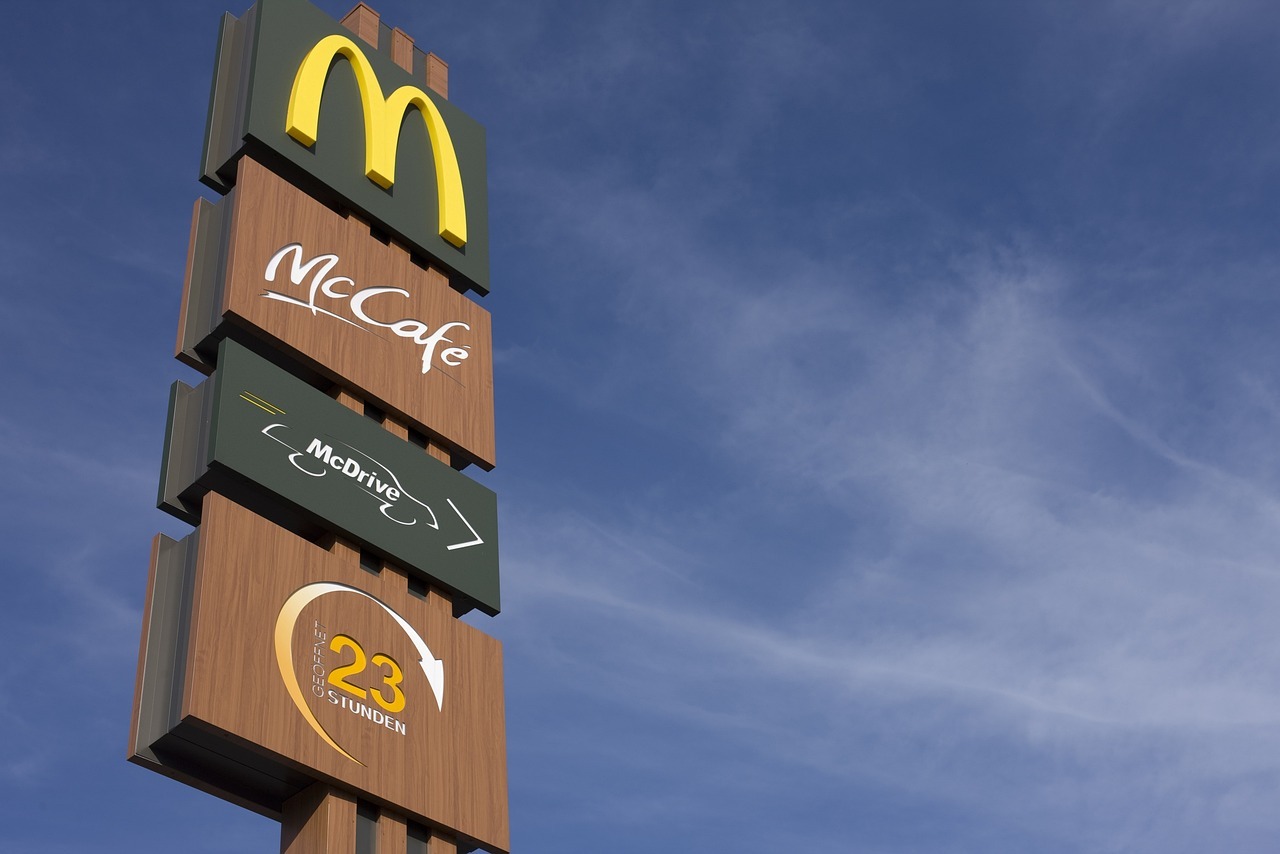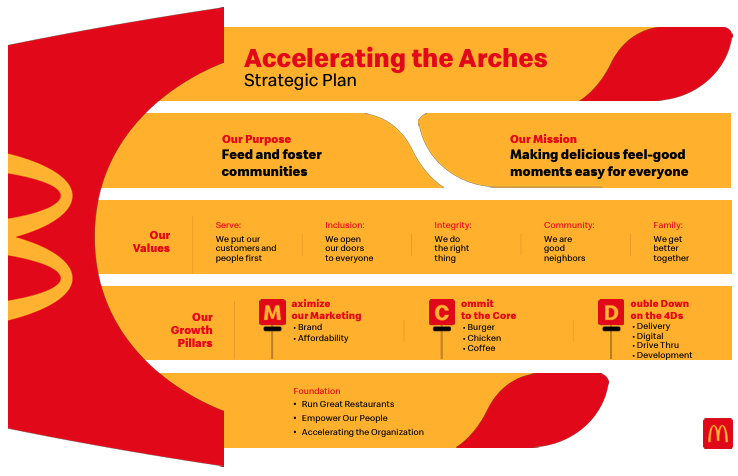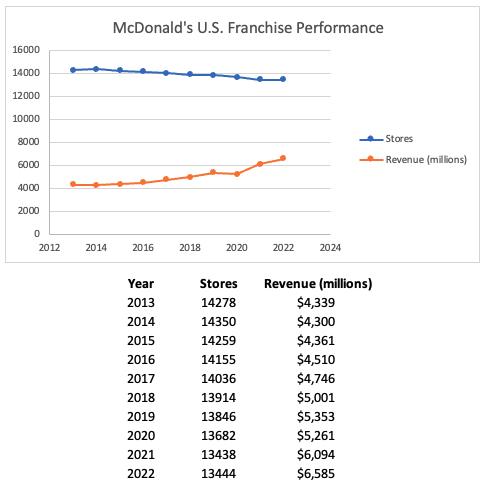You’re not here for a history listen but the evolution of the McDonald’s franchise strategy is one of having a vision and being able to execute.
Brief History of McDonald’s

Established Brand
In the 1940s, the McDonald brothers left New England and headed to California to explore new opportunities. After testing a few concepts, they became experts in operating drive-in restaurants and perfected their “Speedee Service System” in the late 1940s. During this same period, they decided to simplify their menu and focus on only nine items. One of these items was the 15-cent hamburger, which became their signature dish. This burger was so popular and affordable that customers could literally “buy ’em by the bag.” Factoring in inflation, the cost of the hamburger would be approximately $2 in 2023 dollars.
The McDonald’s brothers expanded their burger business using a franchise model and grew to 10 locations. Meanwhile, Ray Kroc was figuring out his career in post-war Chicago. In 1939, he became the distributor of a milkshake mixing machine called the Multimixer. During his travels, he met the McDonald’s brothers and signed a deal to become their franchise agent in 1954. A year later, in April 1955, Ray Kroc opened the first McDonald’s System Inc. location in Des Plaines, Illinois. In 1961, he acquired the rights to the McDonald’s brothers’ company for $2.7 million. In 2023, this would be worth about $28 million!
You can take it from here as within the last 60 years, the company has grown to operate in over 100 countries and 36000 restaurants.
The McDonald’s Brothers Early Strategy
After experimenting with their business ideas and refining their drive-in restaurant operations, they developed and implemented the Speedee Service System. It is clear that their trial-and-error approach to perfecting the drive-in concept led them to realize that having a replicable system would give them a significant advantage over their competitors.
After mastering the system, they examined their marketing strategy. They concluded that their new operational system, which emphasized speed, service, and accuracy, required them to streamline their offerings as well. After conducting a thoughtful analysis, they decided to offer only nine items on their menu. Including the now-famous hamburger, priced at just 15 cents each.
Their operational system was designed for throughput, and their marketing brought the people to service this need. Brilliant!
The Ray Kroc Strategy
Kroc had a vision to take the hamburger chain across the U.S. and build it into a 1000-store operation. Between 1955 and 1961, he perfected the stores he operated. He decided to scale and grow successfully they needed an operational strategy that tied into his vision – Hamburger University. A first of its kind. This would be a training ground for franchisees to show them the key to replicating success and how to follow exacting standards. At the same time, they had a strategy of innovation that would allow them to stay ahead of their competitors. In the 1960’s they introduced the infamous golden arches, Ronald McDonald, and in 1975 the Big Mac.
A key part of their then and ongoing success was the expansion strategy to own the real estate and to lease it to franchisees. Depending on the operating year, these rent payments can be close to 1/5th of the total system revenue. By 1965, they had achieved their 1000-store growth by leveraging the franchise model as a key part of their growth strategy. They focused on finding franchise partners with the capital, work ethic, and passion to build the brand as much as Ray Kroc did.
What is the McDonald’s Business Model?
The company is a franchisor, with around 95% of stores operated by franchisees and 5% either being licensed or operated corporately. A specific breakdown can be found in their annual report. They believe in operating corporate locations as a training and testing ground for new concepts and products. Franchisees operate under a conventional franchise agreement with typical terms being 20 years. McDonald’s owns the land and building or secures a long-term lease for the restaurant location, and the franchisee pays for equipment, signs, seating, and décor. Franchisees are also responsible for reinvesting capital in their businesses over time. To accelerate company initiatives, the company will frequently co-invest with franchisees to fund improvements to restaurants or operating systems.
What is the current McDonald’s Strategy?
Since 2017, they have rolled out their “Accelerating the Arches” strategic plan as referenced in this picture. Their plan is anchored with their vision, mission, and values. As with any strategy, these anchors are part of the DNA of the business and will influence the strategy and execution of it.
The three pillars of their strategy are:
- Maximize our Marketing
- Brand – feed and foster communities
- Affordability – great value and everyday affordability
- Commit to the Core
- Burger – want to offer the tastiest burgers in the QSR industry
- Chicken – offer great tasting chicken options
- Coffee – build McCafé brand and offer a great experience
- Double Down on the 4D’s
- Delivery – want to be the global leader in food delivery
- Digital – build on a digital platform
- Drive-Thru – define the future of drive-thru
- Development – accelerate restaurant openings
They have also added a grounding element to their strategy, which they call foundation:
- Run Great Restaurants
- Empower Our People
- Accelerating the Organization

Visually, their strategy embodies their vision as the message has to resonate with anyone who looks at it. What better way than french fries and ketchup? Their vision, mission, and values will be their guiding light. Their three pillars will provide the overall areas of the business that will continue to be worked on by each department and individual. Lastly, their foundation will be the outcome they seek.
How Does the Strategy Impact Franchisees?
The company strategy rolls out to all franchise and corporately operated locations globally. Although there are regional variations to menus, marketing, and management, the 3 pillars of commitment are embraced by all operating units. To ensure compliance, McDonald’s employs internal scorecards to measure the execution of operational, service, and marketing standards at each of its locations through field operations teams.
What happens if they don’t execute their strategy?
Their 2022 annual report highlights what will happen if they don’t execute their strategy:
STRATEGY AND BRAND
If we do not successfully evolve and execute against our business strategies, we may not be able to drive business growth.
To drive Systemwide sales, operating income and free cash flow growth, our business strategies must be effective in maintaining and strengthening customer appeal and capturing additional market share. Whether these strategies are successful depends mainly on our System’s continued ability to:
- capitalize on our global scale, iconic brand and local market presence to build upon our historic strengths and competitive advantages, including by maximizing our marketing, committing to our core menu items, and doubling down on digital, delivery, drive thru and restaurant development;
- innovate and differentiate the McDonald’s experience, including by preparing and serving our food in a way that balances value and convenience to our customers with profitability;
- build upon our investments to transform and enhance the customer experience;
- run great restaurants by driving efficiencies and expanding capacities while continuing to prioritize health and safety;
- accelerate our existing strategies, including through growth opportunities ; and
- evolve and adjust our strategies in response to, among other things, changing consumer behavior, and other events impacting our results of operations and liquidity.
If we are delayed or unsuccessful in evolving or executing against our strategies, or if our strategies do not yield the desired results,
our business, financial condition and results of operations may suffer.
How do they measure success?
It has to be assumed, success for franchisees, team members, corporate locations, and corporate staff will be made up of a balanced scorecard that embodies the components of the three pillars. From the 2022 annual report, they have outlined key financial metrics they are looking to measure against:
OUTLOOK
Based on current conditions, the following is provided to assist in forecasting the Company’s future results for 2023. The Company expects:
Net restaurant unit expansion will contribute nearly 1.5% to 2023 Systemwide sales growth, in constant currencies.
Full year 2023 selling, general and administrative expenses of about 2.2% to 2.3% of Systemwide sales.
2023 operating margin percent to be about 45%.
Based on current interest and foreign currency exchange rates, the Company expects interest expense for the full year 2023 to increase between 10% and 12%, driven primarily by higher average interest rates.
The Company expects the effective income tax rate for the full year 2023 to be in the 20% to 22% range. Some volatility may result in a quarterly tax rate outside of the annual range.
The Company expects 2023 capital expenditures to be between $2.2 and $2.4 billion, about half of which will be directed towards new restaurant unit expansion across the U.S. and International Operated Markets. Globally, the Company expects to open about 1,900 restaurants. The Company will open more than 400 restaurants in the U.S. and International Operated Markets segments, and developmental licensees and affiliates will contribute capital towards about 1,500 restaurant openings in their respective markets. The Company expects about 1,500 net restaurant additions in 2023.
The Company expects to deliver a free cash flow conversion rate greater than 90%.
How has the company performed over the past 10 years in the U.S. market?

*The company closes locations for a variety of reasons including performance or loss of real estate tenure.
Conclusion
The McDonald’s franchise strategy has embodied a vision, mission, and values that has taken them well into the 21st century as one of the most recognized global brands. It’s only with a continued commitment to their strategy will they be able to achieve their ambitions of continued growth and expected returns to shareholders. Franchise Strategy Co. believes that all companies whether a 1-unit business or a 36,000-unit company can benefit from having a multi-year strategy they can execute on.


